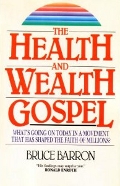The Health and Wealth Gospel. By Bruce Barron. Downers Grove, IL: InterVarsity Press, 1987. 204 pp. Paper, $6.95.
The gospel of healing and prosperity is the parent and child of the modern “faith movement” which has attracted millions of people and spawned some highly visible-and controversial-ministries. Barron’s purpose in writing about the movement is to describe it and evaluate it as accurately as possible in order to “lay the groundwork for meaningful dialog and for resolution of conflict” between the movement and its critics (p. 12).
Barron begins his book with the description of an admittedly extreme case, the cult-like Faith Assembly of Indiana formerly led by the late Hobart Freeman. However, he goes on to give a brief survey of the rise of the more typical elements of the faith movement. He then presents the predominant teachings about healing and prosperity and carefully evaluates each. The three leaders he seems to refer to most are Kenneth Hagin, Kenneth Copeland, and Robert Tilton. A separate chapter (chap. 9) calls attention to the weakness of or lack of good hermeneutical practices by the faith movement’s leaders. The book ends with a chapter on unfortunate experiences caused by the excesses and bad theology of the movement, and a chapter suggesting a mediating position (and attitude) concerning healing and prosperity.
Barron is to be commended for a fair and substantial treatment of the faith movement’s teachers and teachings. He describes the extensive effort to do primary research (even enrolling and graduating from Hagin’s Bible School) in an appendix, but the reader will have no problem trusting his approach from the beginning. He professes to be a charismatic who embarked on the study due to concerns about extremes in the faith movement. He presents the teachings of the movement well and is just as honest in evaluating them. Barron views as the major flaw of the faith movement its inconsistent (or nonexistent) hermeneutic. He cites, principally, neglect of the context, the use of “revelation knowledge” (“The Lord told me”), and the abuse of the interpreter’s authority in influencing others. Unfortunately, he makes no dispensational appeal to bridle the practice of claiming OT promises. Also, he does not deal at all with the effect of faith theology on the content of the Gospel. Barron is more concerned with the effect of faith theology on Christians.
Those who look for a scathing denunciation of the faith movement will not find it in Barron’s book. He seeks to be as objective, fair, and conciliatory as possible. The result is that he succeeds in making the reader more cautious in regard to criticizing the movement while also making him aware of the deficiencies. The book is highly recommended for those who want an accurate look into the faith movement, but have no time for firsthand research. Readers will profit from Barron’s evaluations of faith teachings and from his call for opposing sides to stop unfair accusations and begin honest dialog.
Charles C. Bing
Editorial Board
Journal of the Grace Evangelical Society
Burleson, TX

